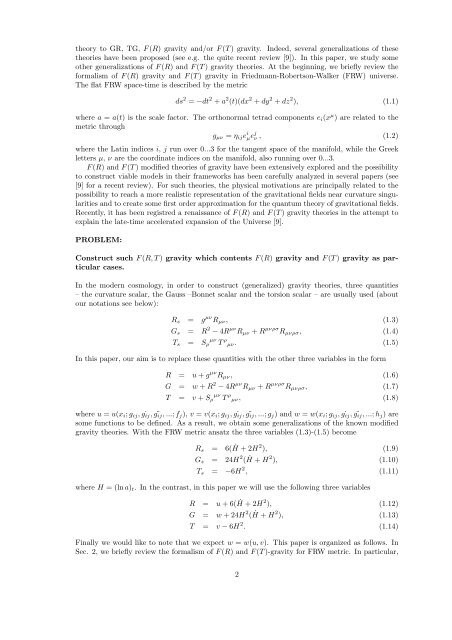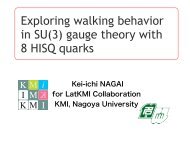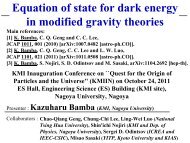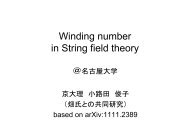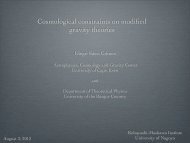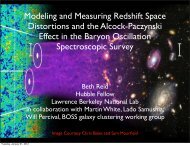Ratbay Myrzakulov
Ratbay Myrzakulov
Ratbay Myrzakulov
You also want an ePaper? Increase the reach of your titles
YUMPU automatically turns print PDFs into web optimized ePapers that Google loves.
theory to GR, TG, F(R) gravity and/or F(T) gravity. Indeed, several generalizations of these<br />
theories have been proposed (see e.g. the quite recent review [9]). In this paper, we study some<br />
other generalizations of F(R) and F(T) gravity theories. At the beginning, we briefly review the<br />
formalism of F(R) gravity and F(T) gravity in Friedmann-Robertson-Walker (FRW) universe.<br />
The flat FRW space-time is described by the metric<br />
ds 2 = −dt 2 + a 2 (t)(dx 2 + dy 2 + dz 2 ), (1.1)<br />
where a = a(t) is the scale factor. The orthonormal tetrad components e i (x µ ) are related to the<br />
metric through<br />
g µν = η ij e i µe j ν , (1.2)<br />
where the Latin indices i, j run over 0...3 for the tangent space of the manifold, while the Greek<br />
letters µ, ν are the coordinate indices on the manifold, also running over 0...3.<br />
F(R) and F(T) modified theories of gravity have been extensively explored and the possibility<br />
to construct viable models in their frameworks has been carefully analyzed in several papers (see<br />
[9] for a recent review). For such theories, the physical motivations are principally related to the<br />
possibility to reach a more realistic representation of the gravitational fields near curvature singularities<br />
and to create some first order approximation for the quantum theory of gravitational fields.<br />
Recently, it has been registred a renaissance of F(R) and F(T) gravity theories in the attempt to<br />
explain the late-time accelerated expansion of the Universe [9].<br />
PROBLEM:<br />
Construct such F(R,T) gravity which contents F(R) gravity and F(T) gravity as particular<br />
cases.<br />
In the modern cosmology, in order to construct (generalized) gravity theories, three quantities<br />
– the curvature scalar, the Gauss –Bonnet scalar and the torsion scalar – are usually used (about<br />
our notations see below):<br />
R s = g µν R µν , (1.3)<br />
G s = R 2 − 4R µν R µν + R µνρσ R µνρσ , (1.4)<br />
T s = S ρ µν T ρ µν. (1.5)<br />
In this paper, our aim is to replace these quantities with the other three variables in the form<br />
R = u + g µν R µν , (1.6)<br />
G = w + R 2 − 4R µν R µν + R µνρσ R µνρσ , (1.7)<br />
T = v + S ρ µν T ρ µν, (1.8)<br />
where u = u(x i ;g ij , g˙<br />
ij , g¨<br />
ij ,...;f j ), v = v(x i ;g ij , g˙<br />
ij , g¨<br />
ij ,...;g j ) and w = w(x i ;g ij , g˙<br />
ij , g¨<br />
ij ,...;h j ) are<br />
some functions to be defined. As a result, we obtain some generalizations of the known modified<br />
gravity theories. With the FRW metric ansatz the three variables (1.3)-(1.5) become<br />
R s = 6(Ḣ + 2H2 ), (1.9)<br />
G s = 24H 2 (Ḣ + H2 ), (1.10)<br />
T s = −6H 2 , (1.11)<br />
where H = (lna) t . In the contrast, in this paper we will use the following three variables<br />
R = u + 6(Ḣ + 2H2 ), (1.12)<br />
G = w + 24H 2 (Ḣ + H2 ), (1.13)<br />
T = v − 6H 2 . (1.14)<br />
Finally we would like to note that we expect w = w(u,v). This paper is organized as follows. In<br />
Sec. 2, we briefly review the formalism of F(R) and F(T)-gravity for FRW metric. In particular,<br />
2


